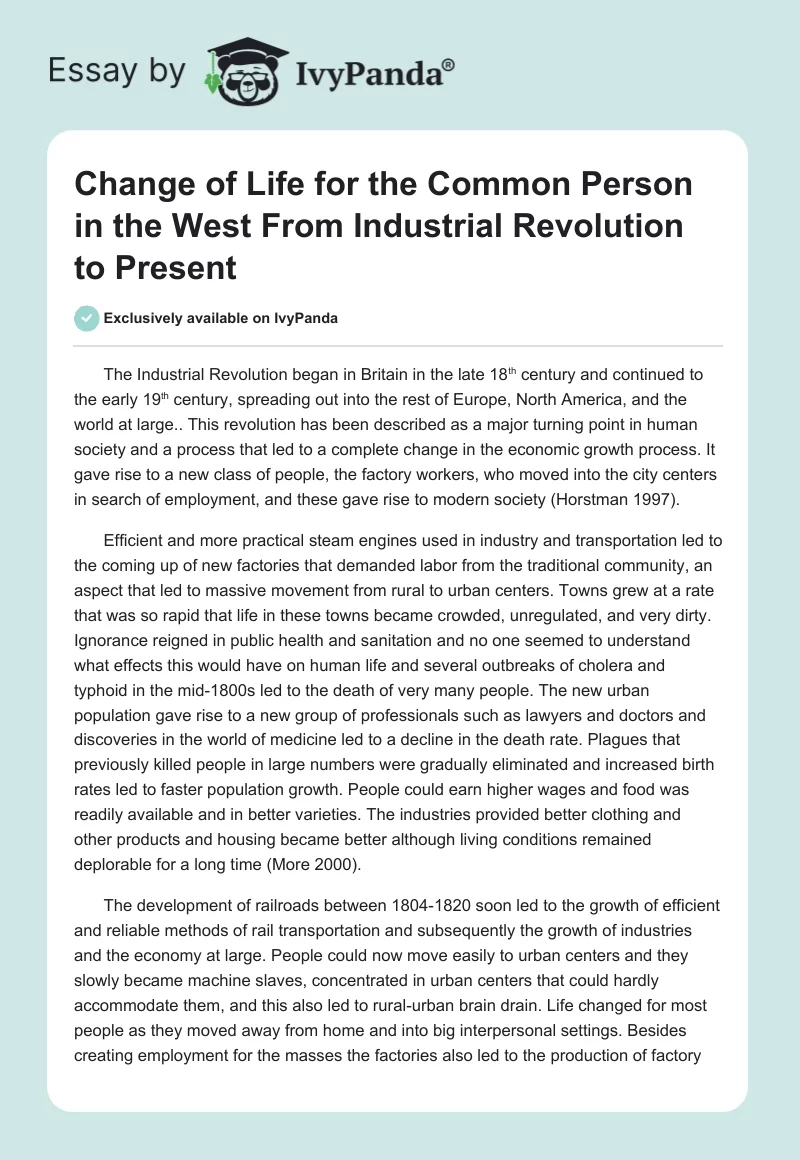The Industrial Revolution began in Britain in the late 18th century and continued to the early 19th century, spreading out into the rest of Europe, North America, and the world at large.. This revolution has been described as a major turning point in human society and a process that led to a complete change in the economic growth process. It gave rise to a new class of people, the factory workers, who moved into the city centers in search of employment, and these gave rise to modern society (Horstman 1997).
Efficient and more practical steam engines used in industry and transportation led to the coming up of new factories that demanded labor from the traditional community, an aspect that led to massive movement from rural to urban centers. Towns grew at a rate that was so rapid that life in these towns became crowded, unregulated, and very dirty. Ignorance reigned in public health and sanitation and no one seemed to understand what effects this would have on human life and several outbreaks of cholera and typhoid in the mid-1800s led to the death of very many people. The new urban population gave rise to a new group of professionals such as lawyers and doctors and discoveries in the world of medicine led to a decline in the death rate. Plagues that previously killed people in large numbers were gradually eliminated and increased birth rates led to faster population growth. People could earn higher wages and food was readily available and in better varieties. The industries provided better clothing and other products and housing became better although living conditions remained deplorable for a long time (More 2000).
The development of railroads between 1804-1820 soon led to the growth of efficient and reliable methods of rail transportation and subsequently the growth of industries and the economy at large. People could now move easily to urban centers and they slowly became machine slaves, concentrated in urban centers that could hardly accommodate them, and this also led to rural-urban brain drain. Life changed for most people as they moved away from home and into big interpersonal settings. Besides creating employment for the masses the factories also led to the production of factory manufactured goods that were cheaper and easier to produce. But horrendous working conditions and long hours of labor characterized life in the factory towns. Early mining and factory jobs required very long hours of labor and women and children were a common characteristic of the labor force. By mid 19th century, child and women labor had been abolished but continued well into the 20th century. The working people organized themselves into friendly societies and cooperatives that served as support groups in hard economic times and these gradually gave rise to trade unions, which became a unified force used by workers to fight against exploitation by the employers (Landes 2003).
Between 1815 and 1860 there was a massive movement of people from Europe to the USA and this led to the creation and growth of urban centers in the US. The new ideas they brought from Europe resulted in the industrialization of these cities and the growth of new industries. By 1850 business organizations had started growing in the USA which by 1900 industrialization had expanded into nation-sized regions, and into global entities by 1950. Advances in technology led to improved agricultural techniques and practices leading to increased food production and supply and food were readily available for the urban dwellers. There was an increased supply of raw materials and this combined with improved production and organization in the industrial sector led to massive production of manufactured goods. The masses now had a variety of products to choose from and this made life very attractive in the urban centers leading to more migration from rural areas. Women and children constituted the labor force in the mines and factories and under lower wages than men. In the first half of the 19th century, there was the establishment of a banking system to help in the distribution of capital to needy areas (Hortsman 1997).
From around 1900 to the present day, practically all inventions made have somehow been improvements or innovations based on the industrial Revolution. As technology and machinery have continued to develop transportation, housework, and occupational work have continued to demand less activity. Machinery is available for many farming and construction jobs and these have led to more efficient production as compared to manual labor. (Landes 2003). Because leisure and jobs are less active, health problems such as obesity are on the increase leading to a boom in the fitness and gymnasium world. Children have become less active and most of their life is now spent in the school environment. The computer is the latest development and this has made working easier as jobs that required a lot of movement can now be done through the computer.
But slavery is back with a lot of vengeance and the modern common man in the west is today not a slave to horrendous living and working conditions like in the past but a slave to taxation, debt, mortgage captivity, and Federal Reserve Banking devices. Working overtime has become the norm in many homes in an attempt to make life affordable. Housing has improved but become more expensive. Though a slave to the world elite the citizen-worker, however, enjoys the freedom of movement, religion, and great choice in many areas of life (Landes 2003).
Works Cited
Horstman, Allen. The Essentials of European History. Research & Education Assoc., 1997.
Landes, David, S. The Unbound Prometheus: Technological Change and Industrial Development. Cambridge University Press, 2003.
More, Charles. Understanding the Industrial Revolution. Routledge, 2000.


